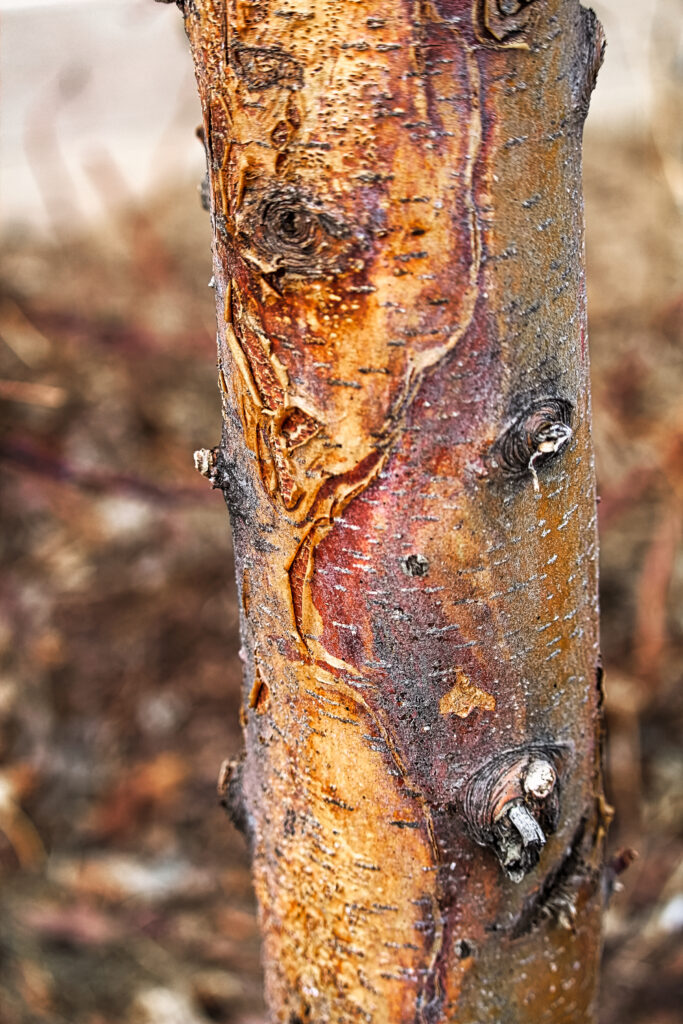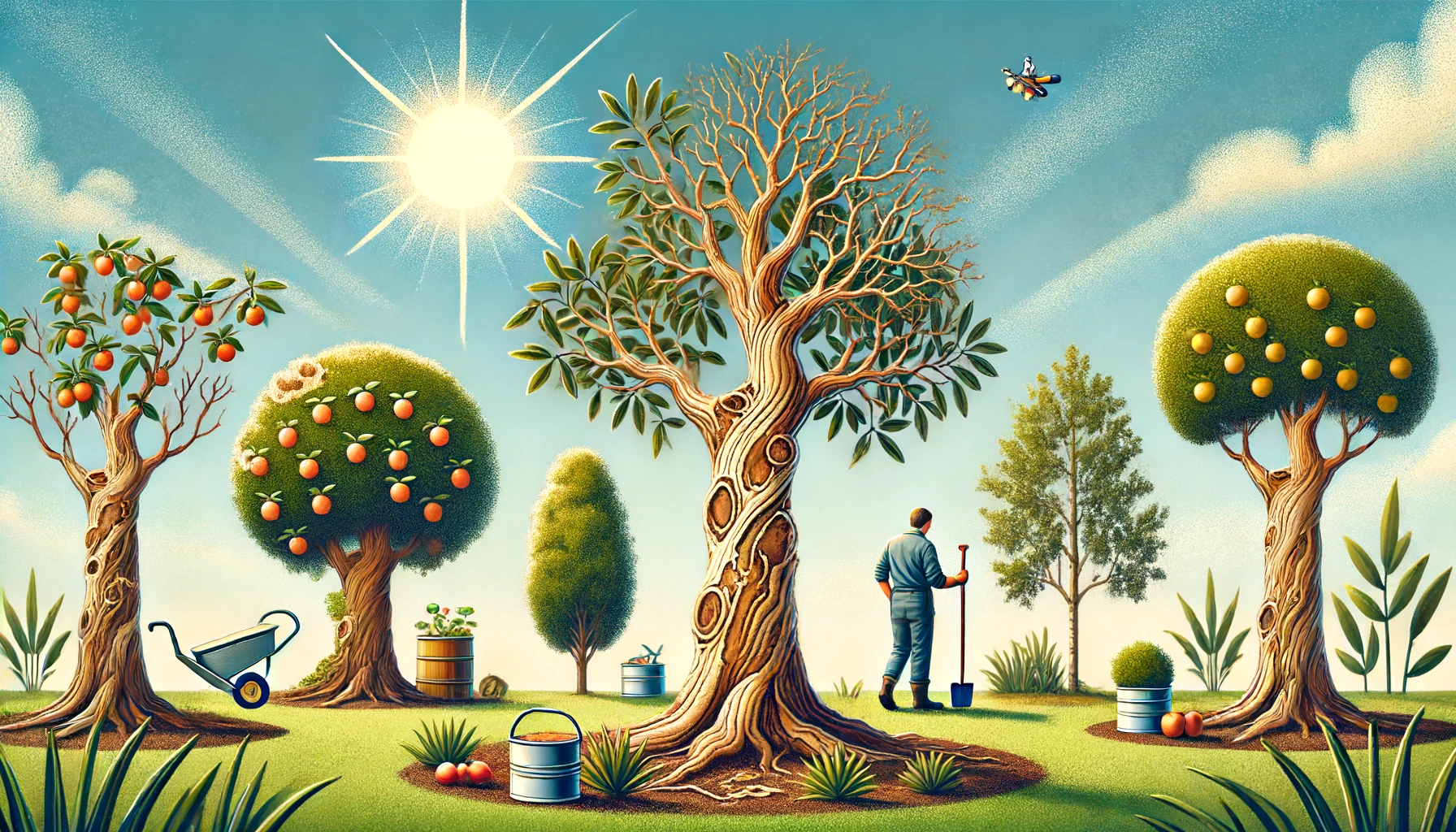Have you ever noticed patches of discolored or cracked bark on your favorite tree? This could be a sign of sunscald, a surprisingly common condition caused by intense sunlight. Just like our own skin, trees can get sunburned!
Healthy trees are vital parts of our landscapes. They provide cooling shade, improve air quality, and add beauty to our surroundings. But when sunscald weakens a tree, it becomes more susceptible to pests, diseases, and even death.
The good news is that sunscald is preventable with a little knowledge and effort. In this blog post, we’ll explore the warning signs of sunscald, the factors that put trees at risk, and most importantly, how to protect your trees from this damaging condition.
Warning Signs of Sunscald
Sunscald might not be immediately obvious, but there are some telltale signs  to watch out for. Let’s look at the visual clues:
to watch out for. Let’s look at the visual clues:
-
- Discolored bark: Sunscald disrupts the bark’s natural color, often causing it to turn brown or reddish-brown.
- Sunken or cracked bark: The affected area may become sunken, creating a depression in the bark. In more severe cases, vertical cracks may appear on the damaged surface.
- “Bleeding”: In the spring, there may also be ‘bleeding’ from the scalded area. As time progresses, bark will begin to slough off.
Now, let’s consider the location of the damage:
- South or southwest side: Since these sides receive the most intense sunlight throughout the day, they’re the most susceptible to sunscald.
- Lower trunk and exposed branches: Sunscald typically affects the lower portion of the trunk, where it’s directly exposed to the sun. Exposed branches, especially those with recent pruning wounds, are also at higher risk.
Factors that Increase Sunscald Risk
Not all trees are created equal when it comes to sun tolerance. Several factors can significantly increase a tree’s risk of developing sunscald. Let’s explore these factors:
Recent changes in sun exposure:
- Newly planted trees in full sun: Young trees with delicate bark are especially vulnerable if suddenly exposed to full sun after being grown in a nursery with shade.
- Sudden removal of surrounding trees/shrubs: Mature trees that have enjoyed the shade of nearby trees can experience sunscald if those trees are abruptly removed.
- Pruning that exposes previously shaded bark: Heavy pruning can remove branches that provided shade for the lower trunk, making it more susceptible to sun damage.
Stress factors: Trees under stress are less able to defend themselves against sunscald. Here are some common stressors:
- Drought: When a tree doesn’t have enough water, it’s less equipped to cope with the additional stress of intense sunlight.
- Nutrient deficiencies: A lack of essential nutrients can weaken a tree, making it more vulnerable to sun damage.
- Pest or disease problems: An ongoing battle with pests or diseases can weaken a tree and increase its susceptibility to sunscald.
How to Prevent Sunscald
The good news is that sunscald is largely preventable with some thoughtful planning and care. Here are some key strategies to keep your trees safe from sun damage:
Planting Considerations
- Sun-loving vs. shade-loving: Start by selecting trees that are well-suited to your sun conditions. Shade-loving trees planted in full sun are much more likely to suffer from sunscald.
- Planting location: Whenever possible, plant new trees in locations that receive some afternoon shade. This can significantly reduce their exposure to the harshest sunlight.
Proper Watering
- Adequate hydration: Ensure your trees receive adequate water, especially during hot and dry periods. A well-hydrated tree is better equipped to handle the stress of intense sunlight.
- Mulch for moisture: Applying a layer of mulch around the base of the tree helps retain moisture in the soil and regulate soil temperature, providing an additional layer of protection.
Sun Protection:
- Temporary paint protection: For newly planted trees in high-risk situations, consider applying a thin coat of white latex paint diluted with water to the trunk. This temporary whitewash reflects sunlight and provides some protection during the critical establishment period.
- Let the leaves do the shading: Avoid excessive pruning on young trees. The leaves naturally provide shade for the developing bark, reducing the risk of sunscald.
Additional Tips and Considerations
Sunscald is most likely to occur on young trees during their first few years of establishment. Here are some additional tips to keep in mind:
- Monitor young trees: Regularly inspect your newly planted trees for signs of sunscald, especially during the first few years. Early detection allows you to take corrective measures to minimize damage.
- Address underlying stress: A healthy tree is better able to withstand sun exposure. If you notice signs of stress like drought, nutrient deficiencies, or pest/disease problems, address them promptly to improve the overall health of your tree.
In some cases, sunscald damage may be severe, especially in mature trees. For situations like these, it’s best to seek professional help:
- Consult an arborist: If you’re dealing with severe sunscald damage or have concerns about sunscald on mature trees, consult with a certified arborist. They can assess the extent of the damage and recommend the best course of treatment.
Keep Your Trees Healthy and Beautiful!
Healthy trees are a vital part of our environment, and protecting them from sunscald is an important step in ensuring their long-term health. By following the tips outlined in this blog post, you can significantly reduce the risk of sun damage to your trees.
Want to learn more or get help with your specific trees?
Our certified arborists at Sexy Trees are passionate about tree care and can provide expert advice on sunscald prevention and treatment. We offer a variety of services to keep your trees healthy and beautiful, year-round. Contact Sexy Trees today for a free consultation!
 Bringing Sexy Back Into Your Yards
Bringing Sexy Back Into Your Yards 
